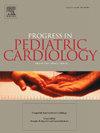Sodium thiopental-induced atrial flutter
IF 0.6
Q4 PEDIATRICS
引用次数: 0
Abstract
Background
Convulsive status epilepticus (CSE) is a critical neurological emergency that requires immediate intervention. Sodium thiopental is frequently used to induce coma in cases of refractory CSE; however, its use can be complicated by severe cardiac side effects.
Case presentation
We report a case of a 7-year-old female with super-refractory status epilepticus secondary to West syndrome, who developed supraventricular tachycardia (SVT) and atrial flutter during a thiopental infusion. Despite receiving multiple anti-seizure medications, including midazolam, ketamine, and thiopental, the patient exhibited persistent seizures. On the fourth of thiopental infusion, she developed SVT and atrial flutter, which resolved following the administration of beta-blockers and the discontinuation of thiopental. Continuous monitoring and prompt intervention led to the successful restoration of sinus rhythm. The patient was discharged on the 28th day of hospitalization.
Discussion
This case underscores the critical importance of vigilant cardiac monitoring during thiopental infusion due to its potential to induce severe arrhythmias. The pathophysiology of thiopental-induced cardiac complications involves its negative inotropic and chronotropic effects, necessitating careful patient selection and proactive management.
Conclusion
Sodium thiopental remains a viable option for managing refractory CSE, but its use requires careful consideration of cardiac risks. Continuous cardiac monitoring and a multidisciplinary approach are essential for optimizing patient outcomes. Further research is needed to elucidate the mechanisms underlying thiopental-induced cardiac complications and to develop preventive strategies.
求助全文
约1分钟内获得全文
求助全文
来源期刊

PROGRESS IN PEDIATRIC CARDIOLOGY
PEDIATRICS-
CiteScore
0.90
自引率
11.10%
发文量
69
审稿时长
75 days
期刊介绍:
Progress in Pediatric Cardiology is an international journal of review presenting information and experienced opinion of importance in the understanding and management of cardiovascular diseases in children. Each issue is prepared by one or more Guest Editors and reviews a single subject, allowing for comprehensive presentations of complex, multifaceted or rapidly changing topics of clinical and investigative interest.
 求助内容:
求助内容: 应助结果提醒方式:
应助结果提醒方式:


